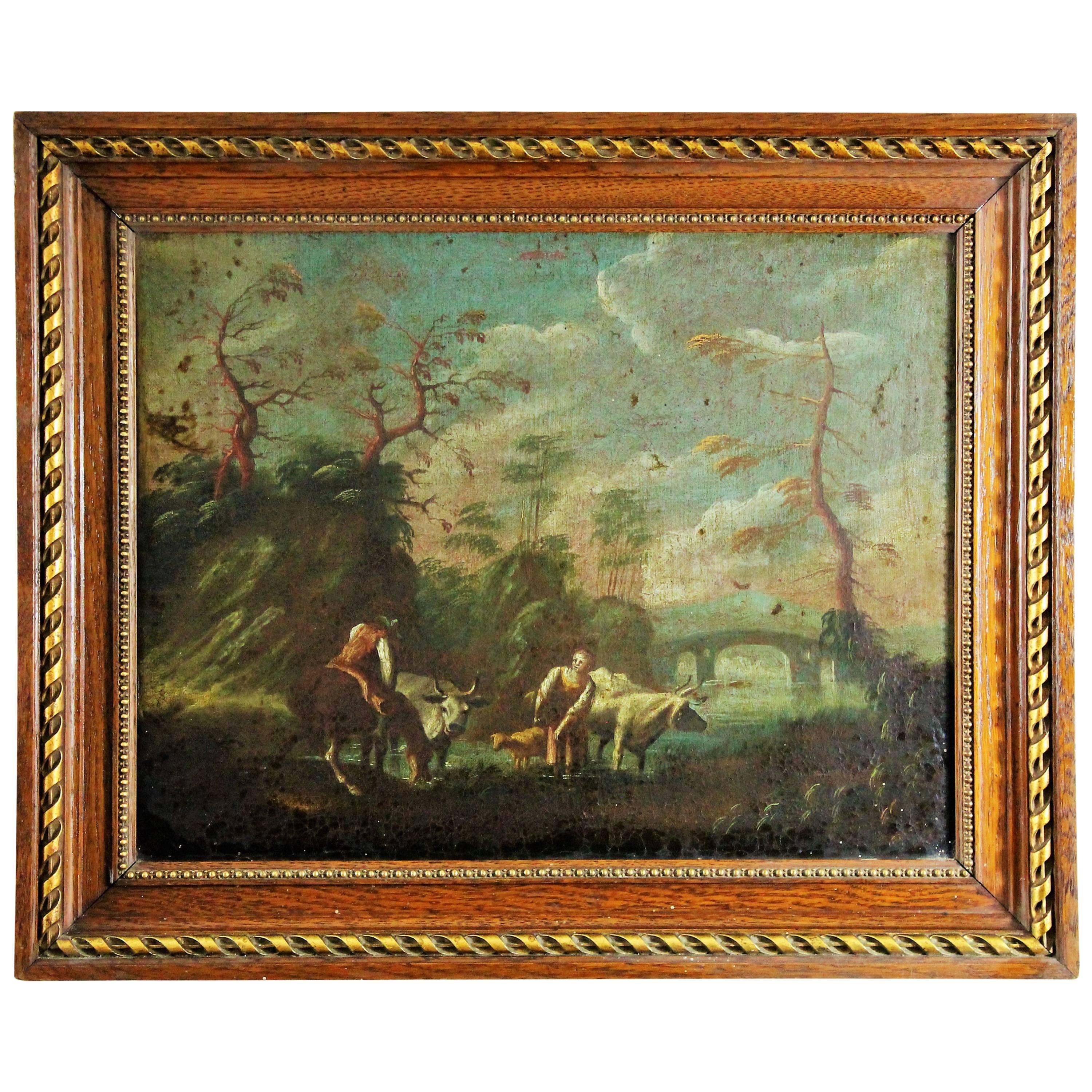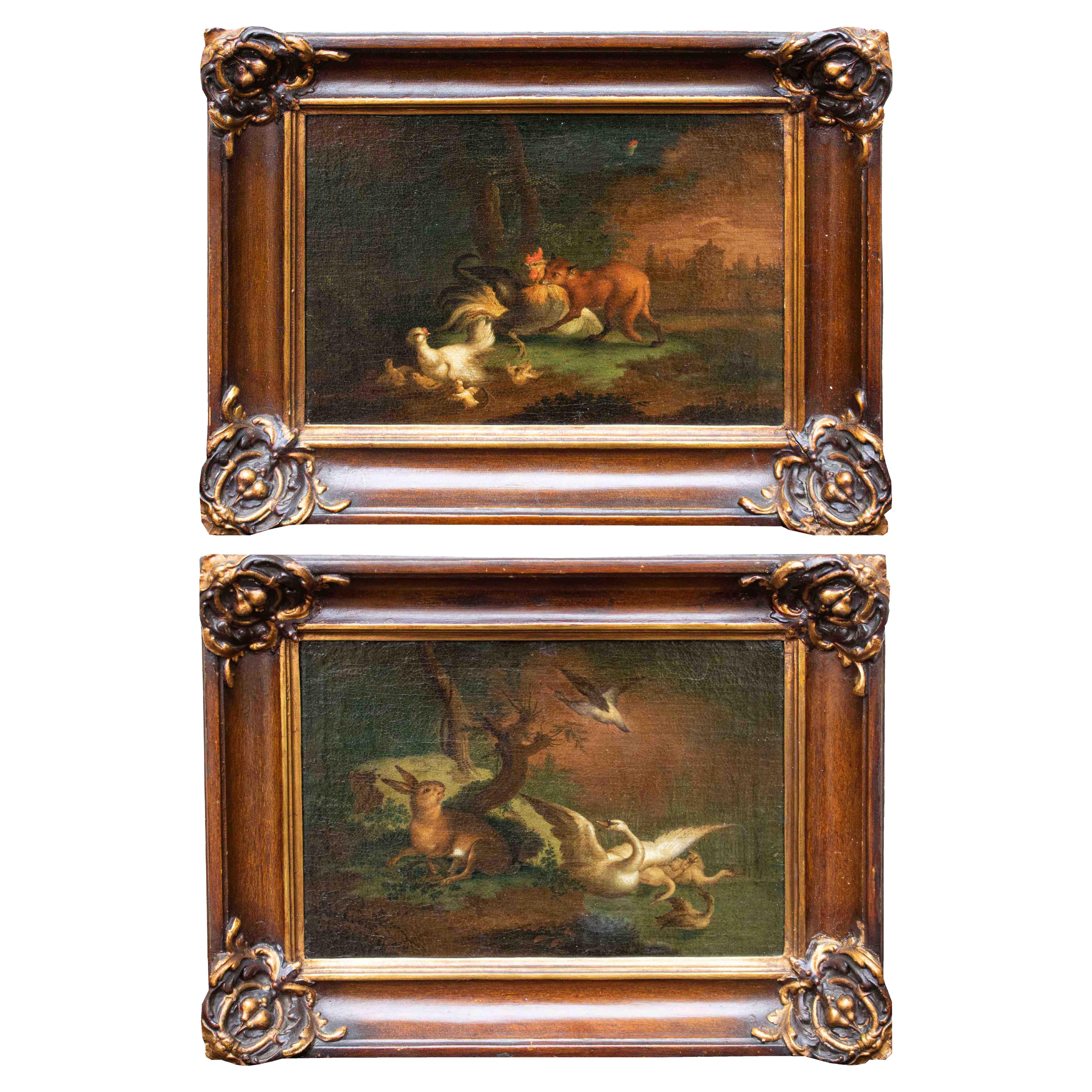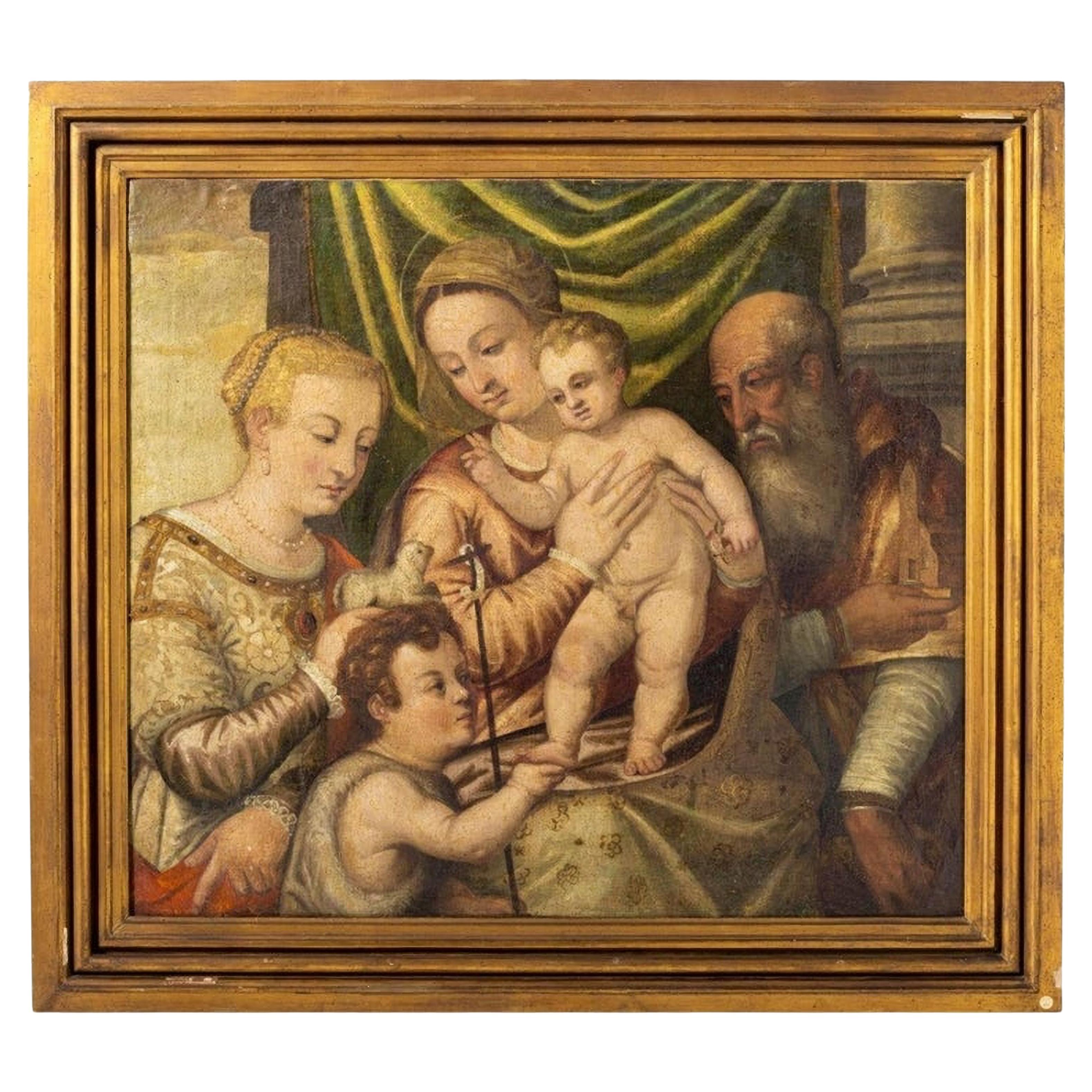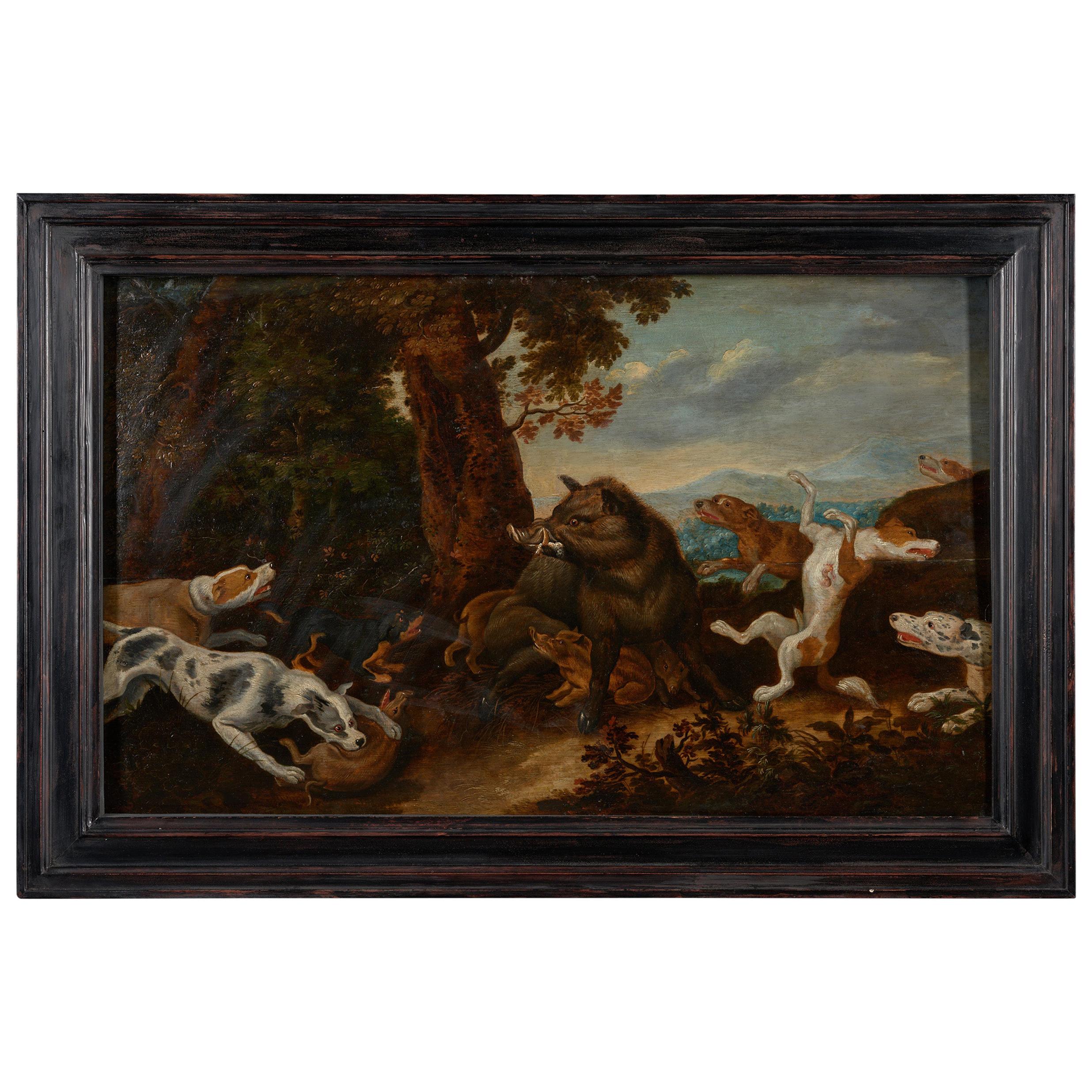Items Similar to 17th Century Flemish School, Saint Francis In Extasy, Oil on Oak Panel
Want more images or videos?
Request additional images or videos from the seller
1 of 9
17th Century Flemish School, Saint Francis In Extasy, Oil on Oak Panel
About the Item
This 17th century panel painting is a depiction of a praying Franciscan monk, or of Saint Francis. The grey-brown habit, the skull and the book are the iconographical elements that identify the monk as Franciscan, or as Saint Francis in prayer. The composition is simple but dramatic. The skull, hands and face of the man are almost monochrome. They are lit by a strong light coming from above. The composition of the scene, the gaze of the central figure, the mannerism of the hands and the religious fervour suggest that the painter was inspired by Spanish painters like Francisco de Zurbarán, or El Greco. De Zurbarán, in particular, regularly painted monks and saints in a state of religious exaltation. The cradling on the back of the panel has been added at a later date.
- Dimensions:Height: 37.8 in (96 cm)Width: 49.02 in (124.5 cm)Depth: 2.37 in (6 cm)
- Materials and Techniques:
- Place of Origin:
- Period:
- Date of Manufacture:Unknown
- Condition:Wear consistent with age and use. Minor losses.
- Seller Location:Leuven , BE
- Reference Number:
About the Seller
5.0
Gold Seller
These expertly vetted sellers are highly rated and consistently exceed customer expectations.
Established in 2017
1stDibs seller since 2017
165 sales on 1stDibs
Typical response time: 7 hours
- ShippingRetrieving quote...Ships From: leuven, Belgium
- Return PolicyA return for this item may be initiated within 3 days of delivery.
More From This SellerView All
- 17th Century Flemish School, Countryside with Peasants at the riverLocated in Leuven , BEIn the 17th century landscape and peasants were a popular painting subject. The panel shows a scene next to a riverbank. The colors are very muted and mainly in shades of brown and g...Category
Antique 17th Century Belgian Decorative Art
MaterialsPaint
- 17th Century Flemish School, Wild Boar Hunt in the Style of Frans SnijdersLocated in Leuven , BE17th century Flemish Shool Antwerp, wild boar hunt in the style of Frans Snijders, oil on oak panel marked by Guilliam Gabron 1609-1662, Antwerp. The st...Category
Antique 17th Century Belgian Paintings
MaterialsPaint
- Flemish School, Painting of Madonna and Child, Oil on Panel, FramedLocated in Leuven , BEThis lovely 17th century painting was made in the last part of the European Renaissance period, also known as the high renaissance, late 17th century. This scene depicts the Madonna with her Child...Category
Antique 17th Century Belgian Decorative Art
MaterialsPaint
- 19th Century French Shool, Cupid & Psyche, Oil on Panel, FramedLocated in Leuven , BEThis 19th century oil on canvas depicts the first kiss between Cupid and Psyche. It symbolizes the moment of innocence right before the sexual awakening happens. The two characters a...Category
Antique Late 19th Century French Paintings
MaterialsHardwood
- After Philips Wouwerman, Stop of the Travelers, Oil on PanelLocated in Leuven , BE“Stop of the travelers” is a charming scene depicting several characters, horses and dogs with a backdrop of woods and a small house. The composition used here is a typical character...Category
Antique 17th Century Belgian Paintings
MaterialsOak, Paint
- Marc Le Rest 'Region of Armorique in France, 1969-', Gypsie 1, Oil on CanvasLocated in Leuven , BEAbout the artist Born in 1970, Marc Le Rest is a French-born artist who turned his back to a promising career within the Holy Church to dedicate himself t...Category
2010s French Paintings
MaterialsPaint
You May Also Like
- Oil on Canvas Paint Flemish School, 17th Century BelgiumLocated in Beuzevillette, FROil on canvas depicting a country scene: a man watering his horse near a river where two cows and a sheep wade accompanied by a farmer. Work of northern France or Belgium of the 17t...Category
Antique 17th Century Belgian Paintings
MaterialsCanvas
- 17th Century Live Nature Pair of Paintings Oil on Canvas Flemish SchoolLocated in Milan, ITFlemish School, 17th century Live nature couple with animals Measures: Oil on canvas, cm 25 x 35 - With frame cm 37 x 48 The pair of canvases in question depicts two excited...Category
Antique 17th Century Paintings
MaterialsCanvas
- Flemish School 17th CenturyBy Europa AntiquesLocated in Madrid, ESFlemish school 17th century "Our Lady with the Child Jesus, St. John, St. Elizabeth and Zacarias". Oil on canvas Relined. Dimensions: 74 x 84 cm good conditions.Category
Antique 17th Century Dutch Baroque Paintings
MaterialsPaint
- 17th Century Mystical Marriage of Saint Catherine Oli on Canvas Roman SchoolLocated in Milan, IT17th century, Roman School Mystical marriage of Saint Catherine of Alexandria Oil on canvas, 32 x 23 cm Frame cm 45 x 36 The saint is depicted in front of the Virgin holding the Child portrayed with the wedding ring in his hand, enriched with a precious stone. According to the Golden Legend, Catherine of Alexandria was a very beautiful young woman, the only daughter of the king of Costa, who had refused to marry the emperor Maxentius because she was a Christian and devoted to Christ. Maxentius, unable to convince her to sacrifice to idols, had sent to call the wisest men and fifty philosophers and orators who presented themselves and tried to divert her from faith in Christ. Catherine, however, played so well that she was able to convert them, arousing the anger of the emperor who condemned them to the stake. Catherine, however, who had criticized Maxentius for the new persecutions against the Christians, was sentenced to prison without food. Abandoned for twelve days, she was fed by a dove sent by God. Maxentius then decided to execute her with the torture of the toothed wheel become her attribute iconographic; but by divine intervention this broke and the young was saved. Finally, she was beheaded and milk flowed from her neck. Catherine’s princely status is witnessed here by her sumptuous dress. The iconography of the mystical marriage was born in the fifteenth century, probably because the traditional iconographic attribute, the wheel, was sometimes so small as to look like a ring, and refers to a vision that will always remain present in the mind and heart of the saint. In Heaven she appeared to her, among the Angels and Saints, Christ the Child, in the arms of the Virgin. He took a precious ring that the Virgin Mary handed to her and put it in her finger, saying "I, your Creator and Saviour, take you in marriage; confident that you will keep you pure until you celebrate your eternal wedding with me, in Paradise" When Catherine was laughing, she found in her finger the same ring that she had seen and had in Heaven, and she considered herself forever the bride of Christ. In this extraordinary episode we can see the heart of Catherine’s religious sense, and of all her spirituality. For her, Christ is like the bridegroom, with whom there is a relationship of intimacy, communion and fidelity; he is the beloved, whom she loves above all...Category
Antique 17th Century Italian Decorative Art
MaterialsCanvas
- Naive School Oil Painting of a Monk, 17th CenturyLocated in St Annes, LancashireWonderful naive oil painting of a monk Great muted colors in unrestored condition Oil on canvas. No stretcher. There is another religious painting on the verso Unsigned. Art...Category
Antique Late 17th Century Dutch Renaissance Paintings
MaterialsCanvas
- 17th Century Christ and the Samaritan Oil on Canvas Roman SchoolLocated in Milan, ITRoman school of the 17th century Landscape with bridge - Christ and the Samaritan woman at the well Oil on canvas, cm 42 x 59,5 - With frame, cm 54, 5 x 71 cm The small canvas portrays a broad view of the city surrounded by a bucolic and lush landscape, probably a reinterpretation of the Roman countryside or the Agro. The fulcrum of the canvas is the bridge consisting of several bays beyond which stands a village. In the distance the landscape made of green mountains opens into what looks like a lake crossed by boats. The landscape is animated by the human presence; not only small and fleeting figurines intent on walking along earthy paths but also the representation, in the foreground, of an Gospel episode, that of Christ and the Samaritan woman at the well. The landscape can be clearly traced back to a painter trained on the examples of the great seventeenth-century Roman baroque landscape that sees in the Lunette Aldobrandini by Annibale Carracci but also in Claude Lorrain, Nicolas Poussin and Gaspar Doghet are its greatest achievers. If in the past, therefore, the landscape was considered the scenic background on which to project the representation of divine or human characters, in the seventeenth century it became an autonomous and codified pictorial genre. With Carracci comes the so-called ideal landscape: a mental reconstruction of a peaceful and harmonious nature in which the dream of a perfect communion with man is realized. In the wake of Hannibal, as mentioned, during the seventeenth century the "classic" Roman landscape knows a long and happy season by artists such as Domenichino, and the French Claude Lorrain, Nicolas Poussin and Gaspar Dughet. Lorrain investigates the Roman countryside in all its aspects, studying the variations in the different hours of the day, the seasons or weather conditions, but always nourished by a sense of bucolic Virgilian. With Poussin the approach becomes intellectual elaboration and sophisticated rational construction. From the examples of the great masters, the Roman Baroque season, from the middle of the century, saw the flourishing of several personalities who, with shots, but also important personal reworkings, led to further spread the genre. Among the personalities that can be compared to the work in question we cannot fail to mention Crescenzio Onofri (1634-1714), defined by Salerno as the only true pupil of Dughet, who then spread in Florence the taste of the Baroque landscape influencing Tuscan painters such as Panfi and Peruzzini. His paintings are in various Roman collections; such as, for example, the landscapes from the Sacchetti Collection and today at the Pinacoteca Capitolina. and those in the Almagià collection in Rome, others in the Palazzo di Montecitorio, but the most conspicuous group is in the Galleria Doria. In comparison we can mention the two passages of the National Gallery in London, the landscape with a bridge over the Antiquarian Market but also the design of the National Gallery of Art in Washington. In the work you can also find the influences of the art of Giovanni Francesco Grimaldi...Category
Antique 17th Century Italian Paintings
MaterialsCanvas
Recently Viewed
View AllMore Ways To Browse
Prayer Wall
Oak Panelled Walls
Oak Wall Panels
Hand Painted Decorative Wall Panels
17th Century Oak Panels
Carved Figural Panel
Spanish Wall Panels
Belgian Carved Oak
Flemish Religious
Hand Painted Carved Saint
Spanish Carved Panel
17th Oil Spain
Antique Grey Oak
17th Century Spanish School
Antique Prayer Book
Monk Figure
Skull Light
Spanish Carved Figure





